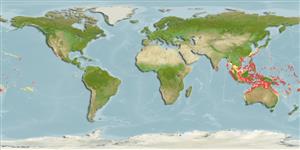>
Ovalentaria/misc (Various families in series Ovalentaria) >
Pseudochromidae (Dottybacks) > Pseudoplesiopinae
Etymology: Lubbockichthys: After Roger Lubbrock, Cambridge University; he died in Brazil in a car accident in 1981. He described and discovered many species in the Rea Sea in 1970 and early 80´s.
Environment: milieu / climate zone / depth range / distribution range
Ecologia
marino associati a barriera corallina; distribuzione batimetrica 0 - 65 m (Ref. 30874), usually 0 - 20 m (Ref. 90102). Tropical
Indo-Pacific: eastern Indian Ocean to central Pacific.
Size / Peso / Age
Maturity: Lm ? range ? - ? cm
Max length : 7.5 cm TL maschio/sesso non determinato; (Ref. 48635)
Short description
Morfologia | Morfometria
Spine dorsali (totale): 2; Raggi dorsali molli (totale): 25-26; Spine anali 1-2; Raggi anali molli: 15 - 16. Appears pink underwater (Ref. 48635).
Occurs inshore (Ref. 7300), in crevices near drop-offs (Ref. 8631, 48635). Also found in caves (Ref 90102).
Life cycle and mating behavior
Maturità | Riproduzione | Deposizione | Uova | Fecundity | Larve
Randall, J.E., G.R. Allen and R.C. Steene, 1990. Fishes of the Great Barrier Reef and Coral Sea. University of Hawaii Press, Honolulu, Hawaii. 506 p. (Ref. 2334)
IUCN Red List Status (Ref. 130435)
Threat to humans
Harmless
Human uses
Acquario: Commerciale
Informazioni ulteriori
Nomi ComuniSinonimiMetabolismoPredatoriEcotossicologiaRiproduzioneMaturitàDeposizioneSpawning aggregationFecundityUovaEgg development
Age/SizeAccrescimentoLength-weightLength-lengthLength-frequenciesMorfometriaMorfologiaLarveDinamica popolazioni larvaliReclutamentoAbbondanzaBRUVS
BibliografiaAcquacolturaProfilo di acquacolturaVarietàGeneticaElectrophoresesEreditarietàMalattieElaborazioneNutrientsMass conversion
CollaboratoriImmaginiStamps, Coins Misc.SuoniCiguateraVelocitàModalità di nuotoArea branchialeOtolithsCervelliVista
Strumenti
Special reports
Download XML
Fonti Internet
Estimates based on models
Preferred temperature (Ref.
123201): 24.9 - 29, mean 27.8 °C (based on 484 cells).
Phylogenetic diversity index (Ref.
82804): PD
50 = 0.6250 [Uniqueness, from 0.5 = low to 2.0 = high].
Bayesian length-weight: a=0.00389 (0.00180 - 0.00842), b=3.12 (2.94 - 3.30), in cm total length, based on all LWR estimates for this body shape (Ref.
93245).
Trophic level (Ref.
69278): 3.5 ±0.6 se; based on size and trophs of closest relatives
Fishing Vulnerability (Ref.
59153): Low vulnerability (10 of 100).
Nutrients (Ref.
124155): Calcium = 160 [82, 271] mg/100g; Iron = 0.841 [0.493, 1.424] mg/100g; Protein = 18.4 [17.3, 19.4] %; Omega3 = 0.121 [0.067, 0.216] g/100g; Selenium = 29.3 [13.1, 63.9] μg/100g; VitaminA = 144 [46, 441] μg/100g; Zinc = 1.99 [1.30, 2.87] mg/100g (wet weight);
